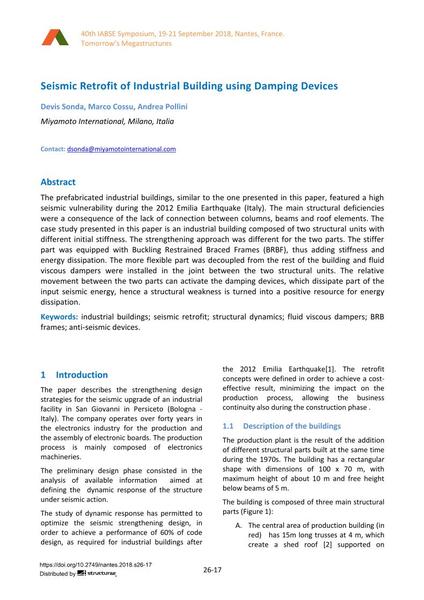Seismic Retrofit of Industrial Building using Damping Devices

|
|
|||||||||||
Détails bibliographiques
| Auteur(s): |
Devis Sonda
(Miyamoto International, Milano, Italia)
Marco Cossu (Miyamoto International, Milano, Italia) Andrea Pollini (Miyamoto International, Milano, Italia) |
||||
|---|---|---|---|---|---|
| Médium: | papier de conférence | ||||
| Langue(s): | anglais | ||||
| Conférence: | IABSE Symposium: Tomorrow’s Megastructures, Nantes, France, 19-21 September 2018 | ||||
| Publié dans: | IABSE Symposium Nantes 2018 | ||||
|
|||||
| Page(s): | S26-17 | ||||
| Nombre total de pages (du PDF): | 8 | ||||
| DOI: | 10.2749/nantes.2018.s26-17 | ||||
| Abstrait: |
The prefabricated industrial buildings, similar to the one presented in this paper, featured a high seismic vulnerability during the 2012 Emilia Earthquake (Italy). The main structural deficiencies were a consequence of the lack of connection between columns, beams and roof elements. The case study presented in this paper is an industrial building composed of two structural units with different initial stiffness. The strengthening approach was different for the two parts. The stiffer part was equipped with Buckling Restrained Braced Frames (BRBF), thus adding stiffness and energy dissipation. The more flexible part was decoupled from the rest of the building and fluid viscous dampers were installed in the joint between the two structural units. The relative movement between the two parts can activate the damping devices, which dissipate part of the input seismic energy, hence a structural weakness is turned into a positive resource for energy dissipation. |
||||
| Mots-clé: |
bâtiments industriels reconception pour effets sismiques
|
||||
